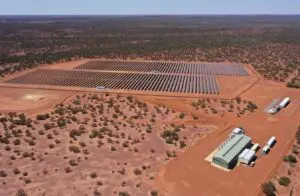A five-year fight by the Mudgee council and local landowners against the 10 megawatt (MW) Burrundulla solar project is over, after a New South Wales court knocked the application back on the grounds of its impact on “scenic quality.”
A judge in the NSW Land and Environment Court agreed it was too close to homes, and mitigation factors such as building mounds of earth to hide the solar panels from neighbours and the road into Mudgee would fundamentally change the landscape character.
“The excessive scale of the proposed solar arrays, located on a site that is within a low-lying, visually sensitive rural landscape setting adjoining the main entrance corridor to Mudgee… demonstrates that the development as proposed is not suitable for the site,” said senior commissioner Susan Dixon in her judgement.
“The Council submits that the development of this solar farm will be an alien feature in the relevant setting, and based on my observation at the site view, I agree. The development, whilst permissible, is uncharacteristic and will intrude into the landscape.”
IT Power’s project consisted of 25,000 panels partly hidden by tree plantings and earth mounds, which the court found would change the undulating views over farmland that Mudgee is known for.
Furthermore, the court latched on to the lack of community consultation undertaken by the developer, which relied on planning controls and expert understanding of what the community appreciated in a landscape as a proxy for talking to people in Mudgee about their concerns.
“It is clear that [landscape architect Suzie Rawlinson] relied upon a generic assessment rather than direct engagement with those most affected by the development. Their sense of place has not been sufficiently factored into her assessment in my view,” Dixon wrote.
The community itself is not opposed to renewable energy projects, but the location of this one at the entrance to the town upset many people, said Mid-Western Regional Council mayor Des Kennedy.
“It was one of those things where 98 per cent of our community [were] in favour of it not being there,” he told A Current Affair.
“Nobody’s dirty on the renewable system, [it] was just the location of it was the entry into our town.
“We’ve got 16 state-significant renewable energy projects on our drawing board and in the planning department now so we have no qualms about it at all.”
Mudgee is in the Central-West Orana renewable energy zone (REZ). In 2022 the council approved a 5MW project on the other side of Mudgee but which was outside of the town, rather than on the outskirts.
“There’s no doubt renewables, and I think every type of renewable – whether its wind or solar, pumped hydro being looked at now as well – we’ve come to a different point now where people are really actively looking at these projects again now and thinking well maybe I don’t want that near me,” NSW Nationals leader Dugald Saunders told Sky News.
“So for proponents of renewable energy there has to be absolutely a social license; there has to be community consultation properly, and we’ve got cumulative impact that’s happening.”
Rules are clear: views also have value
The final hearing in December 2023 was the third time the project had been in court after being rejected by the Mid-Western Regional Council, but a state regulation change in early December changed the way the views around Mudgee now need to be taken into account by renewables developers.
The change meant Mudgee is now a “regional city” under the State Environmental Planning Policy (Transport and Infrastructure) 2021.
It meant that, like for developments around Albury, Armidale, Bathurst, Dubbo, Griffith, Orange, Tamworth and Wagga Wagga, approvals also factor in impacts on “important scenic values” and landscape character.
Councils are allowed to reject solar and wind projects if they will harm or change views, scenic quality of future land use.
The Burrundulla solar project was deep inside the Mudgee city zone.
In August 2022, the NSW Large-Scale Solar Energy Guideline doubled down, saying developers now have to take into account landscape character, which is “an area or sense of place definable by the quality of its built, natural and cultural elements”.










